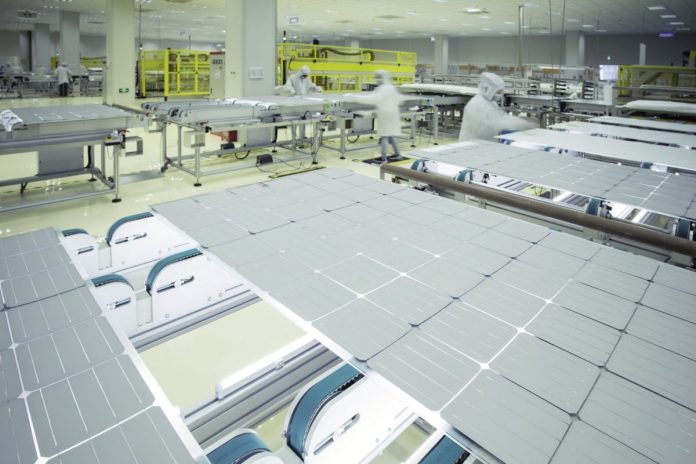With work intensifying on the preparation of China’s 14th five-year plan, one in-country analyst has predicted the renewable energy aspect of the national policy package could transform the Chinese solar sector.
Frank Haugwitz, director of the Asia Europe Clean Energy (Solar) Advisory (AECEA), has predicted changes being drawn up by the authorities will drive “unprecedented industry consolidation” as state-owned entities squeeze out private businesses in the downstream solar project segment of the industry. The analyst also expects Beijing to halt overly-ambitious production capacity expansion and said big solar players could head west.
Ever more ambitious production capacity plans have been outlined by the world’s biggest solar manufacturers since last year, even as energy consumption has slumped around the world because of Covid-19-related industrial shutdowns, prompting oversupply fears. The AECEA has predicted further solar component price falls in the next quarter, on top of an estimated 20% reduction in the cost of making solar wafers and cells during the January-to-May period, and a 10% retreat in module costs during the same window.
Consolidation
“Aggressive scaling up [of production capacity], driving innovation, increasing performance, combined with a continued price reduction pursued by leading companies has the potential to effectively wipe out smaller competitors in the near to mid-term, [and] thus may trigger an unprecedented industry consolidation,” wrote Haugwitz in the AECEA’s latest report on the Chinese PV industry.
The analyst said module production capacity in China was 17% higher in the first three months of the year than in the same period of last year, even though export levels fell slightly, down 3% to 15.6 GW. The authorities have moved to address the oversupply fears by mooting markedly higher minimum efficiency standards for Chinese-made solar products in the form of a guidance policy document issued by the Ministry of Industry and Information Technology. Haugwitz wrote: “If effectively enforced, across the board, numerous existing manufacturers will face an uncertain future and may have to choose to exit the industry, because if such [quality] benchmarks won’t be met, local banks may refrain from providing loans for planned expansions.”
With pv magazine having reported on state-backed bail-outs of indebted solar project developers such as Panda Green and Singyes Solar, and with the main Chinese module production business of solar manufacturer Yingli having passed into the hands of court-appointed administrators last week, the AECEA report also noted the increasing say Beijing-controlled entities are set to have in the nation’s solar projects.
State-owned solar capacity
The consultancy reported power companies and other state-owned enterprises have been “aggressively bidding” for a large share of provincial solar project capacity. For instance, if plans submitted for 2.75 GW of grid-parity projects in the Guangxi autonomous region are approved by the National Energy Administration (NEA), 40% of the projects would be owned by the Chinese government, according to the AECEA.
In terms of new solar capacity, the consultant reported 3.95 GW had been added in the first quarter, with an estimated 1-1.5 GW expected from April and 2-3 GW last month. Haugwitz predicted a surge of new capacity this month as it marks the deadline for connecting projects approved for state subsidy last year.
pv magazine recently reported the maximum grid capacity being made available by China’s three largest grid networks for new solar this year was unlikely to restrict project deployment, based on estimates of how much new solar capacity is expected in 2020. Haugwitz, however, took a different view in yesterday’s report. The analyst pointed out, with 37 project lists – out of 60 demanded from China’s provinces – submitted by Saturday, the plants listed already added up to more capacity than has been freed up by network operators.
Today is the deadline for each of China’s 30 provinces to submit lists of applications for grid parity and for subsidized solar project capacity to the NEA. By Saturday, according to Haugwitz, 20 GW of grid parity applications had arrived from 16 provinces, together with 32 GW of subsidized plants from 21 provinces. That 52 GW of planned capacity already tops the 48.5 GW of the electricity networks offered up by the State Grid Corporation of China, China Southern Power Grid and Inner Mongolia Power Corp.
Grid constraints
The project submissions by the provinces include 110% of the available grid capacity in Guizhou, 133% of the network available in Hubei and 280% of the leeway offered in Ningxia, according to the AECEA, which added, solar electricity had been curtailed at rates of 2.8% in January, 5.6% in February and 1.8% in March, as energy consumption fell thanks to coronavirus containment measures.
The perennial problem facing China’s leaders of having rich renewable energy resources in the west of the vast nation and high-energy-demand population centers in the coastal east, has reportedly prompted the National Development and Reform Commission to offer a tax incentive to industries including solar cell makers and project developers, according to the AECEA. Haugwitz cited a recent decision to slash the tax rate, by 10% to 15%, for businesses which generate at least 60% of their annual income in the west of the nation.
In terms of the new five-year plan – which is expected to be issued for consultation in November and promulgated in early March – Haugwitz predicted a focus on hydrogen and energy storage as well as a possible removal of national renewable energy targets.






